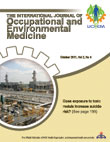فهرست مطالب

International Journal of Occupational and Environmental Medicine
Volume:2 Issue: 4, Oct 2011
- تاریخ انتشار: 1390/07/09
- تعداد عناوین: 8
-
-
Page 191The burden of exposure to blood-borne pathogens (such as hepatitis B and C viruses) is considerable for health care workers. Hepatitis virus transmission requires a non-immune host, an infectious source, and skin or mucous membrane injury. These three aspects are the main fields for preventional interventions. We reviewed major recent studies on this topic to identify precautions health care workers should take to avoid hepatitis B (HBV) and C virus (HCV) infections. Accordingly, this review looks at aspects of epidemiology, risk factors, economy, knowledge, attitudes, practice, and ethics of HBV and HCV that affect health care workers. The risk of transmission depends on the load of pathogen, infectious characteristics and exposure frequency. Health care workers skill levels and the specific hospital department involved appear to be the most important factors in the exposure of health care workers to blood-borne pathogens. However, many health care workers surveyed, believed that educational programs about standard precautions in their setting were not adequate. Obviously, more detailed studies will be needed to clarify risks and opportunities for health care workers precautions aimed at avoiding HBV and HCV infection, especially in emerging health research communities.
-
Page 199BackgroundSuicide is a problem worldwide and occupation is an important risk factor. In the last decade, 55 200 deaths in the US were attributed to occupational risk factors.ObjectiveTo determine if toxic metal exposure was associated with suicide risk among Paducah gaseous diffusion plant (PGDP) workers.MethodsWe assembled a cohort of 6820 nuclear industry workers employed from 1952 to 2003. A job-specific exposure matrix (JEM) was used to determine metal exposure likelihood. Uranium exposure was also assessed by urinalysis. All suicide/self-injury International Classification for Disease (ICD) codes were used to identify suicides. Standardized mortality ratios (SMR), odds ratios (OR), and hazard ratios (HR) were used to estimate suicide risk.ResultsPGDP suicide victims typically were younger white men. Within exposure likelihood categories, several suicide SMRs were typically elevated for several metals. Only beryllium exposure likelihood was associated with an increased HR. Uranium urine concentration was associated with an elevated suicide risk after stratification by urinalysis frequency.ConclusionSuicide risk is associated with uranium exposure.
-
Page 215BackgroundSharps injuries (SIs) are one of the most serious occupational accidents among nurses due to the possible severe consequences, such as the transmission of infectious diseases and inducing of mental impairment.ObjectiveTo discover the prevalence of SIs among nurses in a regional hospital in Thailand and to identify factors associated with SIs.MethodsA cross-sectional study was conducted in 2011. Stratified random sampling was used to select the respondents, with wards as the strata and the number of nurses selected proportional to the size of the ward nurse population. 261 self-administered questionnaires were distributed to nurses who used needles, syringes or other sharp medical equipment in their work. Data were analyzed using chi-square tests, correlation analysis and multiple logistic regression analysis.ResultsThe prevalence of SIs for the previous 12 months was 55.5% among the 250 nurses who returned a completed questionnaire. Of these, 91.1% were with blood. Needles (52.8%) were the main cause of SIs. The reporting rate of SIs to the hospital was 23.8%. SIs had a significant association with each of marital status, work duration, work department, attitude regarding SI prevention, and preventive management. Using multiple logistic regression analysis, attitude was found to be the strongest predictor of SIs when adjusted for other factors. Nurses who had negative attitudes towards prevention of SIs were nearly two times more likely to have SIs than those with positive attitudes (adjusted odds ratio=1.86; 95% CI: 1.03–3.38).ConclusionThe study showed a high prevalence of SIs, but a low reporting rate. This suggests the reporting system requires simplification and also should include a quick response management component. Promoting positive attitudes to SI prevention, and improving the reporting system would reduce SIs
-
Page 224BackgroundThe natural history and etiology of malignant mesothelioma (MM) is already thoroughly described in the literature, but there is still debate on prognostic factors, and details of asbestos exposure and possible context with clinical and demographic data, have not been investigated comprehensively.ObjectivesDescription of patients with MM, focusing on exposure, occupation, survival and prognostic factors.MethodsReview of medical records of patients with MM from 1984 to 2010 from a Danish Occupational clinic. Survival was estimated using Kaplan-Meier survival analysis and prognostic factors were identified by Cox regression analysis.Results110 (90.2%) patients were male, and 12 (9.8%) were female. The median (interquartile rang [IQR]) age was 65 (13) years. Pleural MM was seen in 101 (82.8%) patients, and peritoneal in 11 (9.0%); two (1.6%) had MM to tunica vaginalis testis, and eight (6.6%) to multiple serosal surfaces. We found 68 (55.7%) epithelial tumors, 26 (21.3%) biphasic, and 6 (4.9%) sarcomatoid. 12 (9.8%) patients received tri-modal therapy, 66 (54.1%) received one-/two-modality treatment, and 36 (29.5%) received palliative care. Asbestos exposure was confirmed in 107 (91.0%) patients, probable in four (3.3%), and unidentifiable in 11 (9.0%). The median (IQR) latency was 42 (12.5) years. Exposure predominantly occurred in shipyards. The median overall survival was 1.05 (95% CI: 0.96–1.39) years; 5-year survival was 5.0% (95% CI: 2.0%–13.0%). Female sex, good WHO performance status (PS), epithelial histology and tri-modal treatment were associated with a favorable prognosis.ConclusionMM continuously presents a difficult task diagnostically and therapeutically, and challenges occupational physicians with regard to identification and characterization of asbestos exposure.
-
Page 237BackgroundRaw sewage contains various pathogenic organisms including bacteria, viruses, fungus, worms and protozoa. Workers at wastewater treatment plants (WWTPs) are exposed to these organisms as well as to H2S gas causing many health hazards.ObjectivesTo assess some work-related health effects among WWTPs workers with special emphasis on the most common infections as well as cardiopulmonary disorders.Methods43 workers at Berket Al-Sabih WWTPs were studied. An equal number of non-exposed comparison group were also studied. All participants were asked about their personal demographic data, symptoms suggesting infection, respiratory tract impairment and cardiovascular manifestations. Spirometric measurements were made at the end of the work shift. A resting standard 12-lead ECG was also taken for each participant. For those with a positive ECG finding, echocardiography was also performed. Serum examination for antibodies against hepatitis A virus (HAV) and hepatitis E virus (HEV) was also done. A heparinized blood sample to measure sulf-hemoglobin, as an indicator of H2S exposure, was taken. Stool was analyzed by polymerase chain reaction (PCR) for Leptospira spirochete.ResultsWWTPs workers suffered from body ache, abdominal pain, wheeze, asthma and dyspnea more frequently than the comparison group (p<0.05). An obstructive pattern of pulmonary function impairment and a higher mean sulf-hemoglobin% were significantly more common among WWTPs workers than the comparison group. Antibody levels against HAV and HEV as well as frequency of positive stool PCR test results for L. spirochete were significantly higher among WWTPs workers than the comparison group. The prevalence of left ventricular hypertrophy (LVH) according to ECG and mean ejection fraction (EF) as measured by echocardiography were significantly more frequent in WWTPs workers than in the comparison group.ConclusionWWTPs workers are high risk of developing various infections and cardiopulmonary diseases.
-
Page 245BackgroundThe concentration of heavy metals in drinking water is very important.ObjectivesTo to evaluate the chemistry of some heavy metals in surface drinking water of Dakahlia Governorate, Egypt.Methods51 surface drinking water samples were collected from the main surface water stations and compact units in October 2009 and analyzed chemically. 26 water samples were analyzed by atomic absorption spectrophotometer for iron, manganese, lead, nickel, chromium, zinc, copper, cobalt, aluminum, and cadmium concentrations.ResultsAluminum concentration was slightly high in water sample of Bosat network. Cadmium concentration in samples of up-streams of shark and Mit-Khamis stations, networks of Mit-Antar, Demera, Bosat, Bilqas, El-satamony, El-Gamalia, Mit-asim and Bilqas station exceeded the permissible limits of Egyptian Ministry of Health (EMH, 2007) and World Health Organization (WHO, 2008). The nickel concentration in the network samples taken from Shoha, Bosat and El-Gamalia as well as up-stream of Bosat station exceeded the permissible limits. Also, lead concentrations of the network samples of Shoha, Mit-Antar, Demera and Nabaru exceeded the permissible limits.ConclusionRegular chemical analysis of surface drinking water is required. Since these heavy metals are most likely originate from steel, plastics and batteries industries working in the region, we believe that activities of these industries must be stopped or at least limited in urban zones.
-
Page 254


